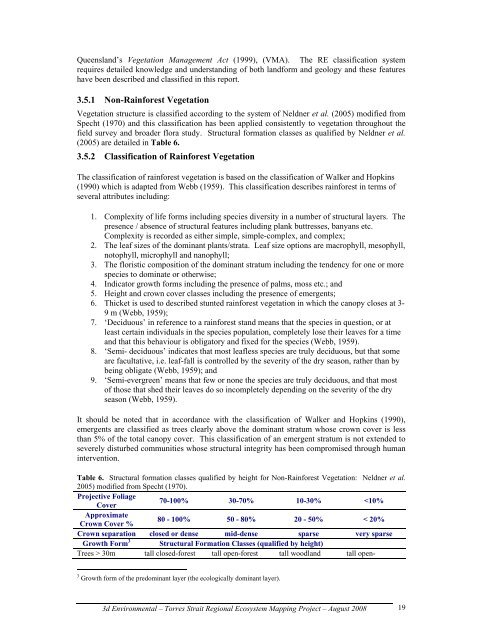Appendix 2 - Vegetation Communities and Regional Ecosystems
Appendix 2 - Vegetation Communities and Regional Ecosystems
Appendix 2 - Vegetation Communities and Regional Ecosystems
Create successful ePaper yourself
Turn your PDF publications into a flip-book with our unique Google optimized e-Paper software.
Queensl<strong>and</strong>’s <strong>Vegetation</strong> Management Act (1999), (VMA). The RE classification system<br />
requires detailed knowledge <strong>and</strong> underst<strong>and</strong>ing of both l<strong>and</strong>form <strong>and</strong> geology <strong>and</strong> these features<br />
have been described <strong>and</strong> classified in this report.<br />
3.5.1 Non-Rainforest <strong>Vegetation</strong><br />
<strong>Vegetation</strong> structure is classified according to the system of Neldner et al. (2005) modified from<br />
Specht (1970) <strong>and</strong> this classification has been applied consistently to vegetation throughout the<br />
field survey <strong>and</strong> broader flora study. Structural formation classes as qualified by Neldner et al.<br />
(2005) are detailed in Table 6.<br />
3.5.2 Classification of Rainforest <strong>Vegetation</strong><br />
The classification of rainforest vegetation is based on the classification of Walker <strong>and</strong> Hopkins<br />
(1990) which is adapted from Webb (1959). This classification describes rainforest in terms of<br />
several attributes including:<br />
1. Complexity of life forms including species diversity in a number of structural layers. The<br />
presence / absence of structural features including plank buttresses, banyans etc.<br />
Complexity is recorded as either simple, simple-complex, <strong>and</strong> complex;<br />
2. The leaf sizes of the dominant plants/strata. Leaf size options are macrophyll, mesophyll,<br />
notophyll, microphyll <strong>and</strong> nanophyll;<br />
3. The floristic composition of the dominant stratum including the tendency for one or more<br />
species to dominate or otherwise;<br />
4. Indicator growth forms including the presence of palms, moss etc.; <strong>and</strong><br />
5. Height <strong>and</strong> crown cover classes including the presence of emergents;<br />
6. Thicket is used to described stunted rainforest vegetation in which the canopy closes at 3-<br />
9 m (Webb, 1959);<br />
7. ‘Deciduous’ in reference to a rainforest st<strong>and</strong> means that the species in question, or at<br />
least certain individuals in the species population, completely lose their leaves for a time<br />
<strong>and</strong> that this behaviour is obligatory <strong>and</strong> fixed for the species (Webb, 1959).<br />
8. ‘Semi- deciduous’ indicates that most leafless species are truly deciduous, but that some<br />
are facultative, i.e. leaf-fall is controlled by the severity of the dry season, rather than by<br />
being obligate (Webb, 1959); <strong>and</strong><br />
9. ‘Semi-evergreen’ means that few or none the species are truly deciduous, <strong>and</strong> that most<br />
of those that shed their leaves do so incompletely depending on the severity of the dry<br />
season (Webb, 1959).<br />
It should be noted that in accordance with the classification of Walker <strong>and</strong> Hopkins (1990),<br />
emergents are classified as trees clearly above the dominant stratum whose crown cover is less<br />
than 5% of the total canopy cover. This classification of an emergent stratum is not extended to<br />
severely disturbed communities whose structural integrity has been compromised through human<br />
intervention.<br />
Table 6. Structural formation classes qualified by height for Non-Rainforest <strong>Vegetation</strong>: Neldner et al.<br />
2005) modified from Specht (1970).<br />
Projective Foliage<br />
Cover<br />
70-100% 30-70% 10-30% 30m tall closed-forest tall open-forest tall woodl<strong>and</strong> tall open-<br />
3 Growth form of the predominant layer (the ecologically dominant layer).<br />
3d Environmental – Torres Strait <strong>Regional</strong> Ecosystem Mapping Project – August 2008<br />
19


